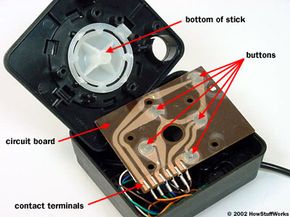The Simplest System: Design
The basic idea of a joystick is to translate the movement of a plastic stick into electronic information a computer can process. Joysticks are used in all kinds of machines, including F-15 fighter jets, backhoes and wheelchairs. In this article, we'll be focusing on computer joysticks, but the same principles apply to other sorts of joysticks.
The various joystick technologies differ mainly in how much information they pass on. The simplest joystick design, used in many early game consoles, is just a specialized electrical switch.
Advertisement
This basic design consists of a stick that is attached to a plastic base with a flexible rubber sheath. The base houses a circuit board that sits directly underneath the stick. The circuit board is made up of several "printed wires," which connect to several contact terminals. Ordinary wires extend from these contact points to the computer.
The printed wires form a simple electrical circuit made up of several smaller circuits. The circuits just carry electricity from one contact point to another. When the joystick is in the neutral position -- when you're not pushing one way or another -- all but one of the individual circuits are broken. The conductive material in each wire doesn't quite connect, so the circuit can't conduct electricity.
Each broken section is covered with a simple plastic button containing a tiny metal disc. When you move the stick in any direction, it pushes down on one of these buttons, pressing the conductive metal disc against the circuit board. This closes the circuit -- it completes the connection between the two wire sections. When the circuit is closed, electricity can flow down a wire from the computer (or game console), through the printed wire, and to another wire leading back to the computer.
